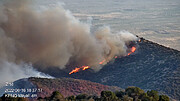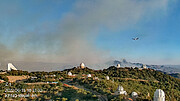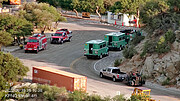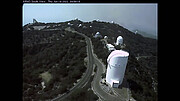Contreras Fire Reaches Kitt Peak National Observatory
13 July 2022
The Contreras Fire reached the Kitt Peak National Observatory during the early morning of Friday 17 June 2022. We are working with the firefighters at the site to assess the damage and will share details about the facilities as we learn more. We remain in an active fire situation with rapidly changing conditions.
Update 7 October:
Though much work still needs to be done, many of the telescopes and key scientific instruments located at Kitt Peak National Observatory affected by the June 2022 Contreras Fire have now returned to service and are once again exploring the Universe.
Update 2 September:
At Kitt Peak National Observatory (KPNO), we are making good progress to recover from the disruption of the Contreras Fire. Based on the most recent updates from the Tohono O’odham Utility, we expect grid power to be restored at the main site around 1 October, with data services restored by the end of October. Work on the power infrastructure and road has been hampered by the monsoon rains.
Currently engineering tests of several telescopes are in progress. It is expected that there will be a “soft” science start-up for some of the KPNO facilities using generator power with limited data services in the next few days.
The Nicholas U. Mayall 4-meter Telescope and the Dark Energy Spectroscopic Instrument (DESI) both appear to be functioning as expected at the present time. DESI is among the most powerful spectrographs in the world and is supported by the Department of Energy Office of Science and the Lawrence Berkeley National Laboratory.
Access to the road must follow the protocols set by the Arizona Department of Transportation and NOIRLab, and the road still remains closed to the public.
Update 1 August:
All science operations at Kitt Peak National Observatory are still suspended after the Contreras Fire. Essential tasks (inspections, clean-up, and preventing equipment damage) continue in anticipation of a larger remediation workforce from 1 August.
The site is transitioning from Phase II of our fire recovery (assessments from independent contractors and damage control), into Phase III, dome-to-dome evaluations. We are happy to invite tenants, and staff back to the summit starting on 1 August, but access to the road must follow the protocols set by the Arizona Department of Transportation and NOIRLab. The road remains closed to the public.
Update 21 July:
Following the Contreras Fire, we are now moving beyond the immediate safety and damage assessment at Kitt Peak National Observatory into restoring the site sufficiently to enable return of operations and science teams. While SR 386, the access road to Kitt Peak controlled by Arizona Department of Transportation, remains closed to the public, they have allowed our essential crews use of the road to travel to the summit.
Grid power has not been restored and will not be restored for several weeks. Observatory staff are working with the Tohono O’odham Utility Authority to reestablish power lines, data services, and utility poles.
As previously stated, the fire caused the loss of one dorm and one cabin on the southwest ridge and a small shed located behind the fire barn, as well as damage to the road. Damage to interiors, especially the telescopes, instruments and other scientific infrastructure, will only be known after the telescope teams are able to spend more time on site. The total cost for restoring the observatory functions is also not yet known.
A great deal of remediation and repair need to occur before science teams and other personnel can safely visit. Only after the return to science operations will we consider reopening the site to the public. The road must be reopened by the Arizona Department of Transportation before public access can resume.
Update 13 July:
The Contreras Fire damage assessment at Kitt Peak National Observatory (KPNO) is progressing well with expert contractors and staff assessing the safety on site as well as damage from heat, smoke, and secondary effects. Arizona State Route 386 up to KPNO remains closed to the public. Access is limited to the site to only staff and contractors due to safety concerns related to missing guardrails, rapidly occurring rainfalls, and fire debris runoff during the monsoon season. We continue to work to make the site safe.
Power and other services are being restored, but it will still take several weeks before the power lines are reestablished. Once potable water, food, and basic amenities are available the science teams will be invited back on site to start their work to return KPNO to operations.
Update 28 June pm:
The fire crews have departed the area around Kitt Peak National Observatory (KPNO).
Arizona State Route 386 up to KPNO remains closed to the public but has been cleared of mud although some debris from the rain remains in a few places. There is still only limited access to the site for staff for safety reasons, but this should improve in the coming days as the site safety can be assessed and the last smaller hotspots cool down. We are working with the Tohono O'odham Nation police and the Arizona Department of Transportation to manage access to the site.
Damage assessment has started with visual inspections of buildings and telescope domes. Three structures have been destroyed; 1 dorm and 1 cabin on the southwest ridge and a small shed located behind the fire barn.
A Bureau of Land Management Burned Area Emergency Response Team is taking steps to start their post-wildfire recovery work in the area to reduce flood severity and soil erosion. We are grateful to this team for their contribution to getting Kitt Peak back to safe operations.
New images have been added to the right.
Update 24 June pm:
The Eastern Area Type 2 Incident Management Team in charge of the Contreras fire expects minimal fire activity going forward at Kitt Peak National Observatory (KPNO) and is now gradually demobilizing their team and equipment. A few firefighters will be on site for the next few days. Although the area affected by the Contreras Fire around KPNO has grown to almost 30,000 acres, the fire is now 100% contained.
The main KPNO generator has been brought back to an operational state allowing power for the water system, which is good news.
However, an early start of the monsoon season in Arizona is complicating our damage assessment and rain is in the forecast for 4 of the next 6 days. Mudslides in the burn area have deposited foot-deep mud on the summit road (Arizona State Route 386) delaying access. A Bureau of Land Management Burned Area Emergency Response Team will now start their post-wildfire recovery work in the area to reduce flood severity, soil erosion and other issues.
We send our heartfelt thanks to the firefighters for their work to protect KPNO over the past two weeks.
Update 21 June pm:
Today the area affected by the Contreras fire increased by 4,401 acres to a total of 24,761 acres. Containment increased to 50% according to the Eastern Area Incident Management Team.
The Team reports that fire around the eastern flank of the summit of Kitt Peak National Observatory is now controlled and they expect to have the northern flank controlled today. The fight is not over for our Tohono O'odham neighbors and we are keeping these communities in our thoughts.
Conditions have moderated dramatically today and annual monsoon clouds have started slowly building. The road to Kitt Peak will continue to be closed with access restricted as the monsoon rain may cause additional issues with the road.
We have no new information that would conflict with the prior assessment that all of the domes and other scientific structures are intact.
We will time our updates as new developments with the fire warrant. We will post new information as our crews are able to access the Observatory site, once temporary basic services have been re-established, and can start assessing any damage. We are indebted to the fire crews for their continued work on the Contreras fire. The DESI collaboration, whose state-of-the-art instrument is on the Nicholas U. Mayall 4-meter Telescope, shared a heartwarming video expressing their gratitude.
Update 20 June pm:
Active fire fighting remains in progress at, and around, Kitt Peak National Observatory. In the last 24 hours, the affected area increased by 1,517 acres to a total of 20,360 acres. The fire remains at 40% containment, according to the Eastern Area Incident Management Team, the group managing the response.
Aerial firefighting from planes and helicopters continues above Kitt Peak and neighboring communities today.
It has not been possible to visit the observatory with a damage assessment team yet to evaluate the state of the telescopes. The entire observatory is still considered too dangerous and is open only to the firefighting teams.
The Team today reported that the fire is mostly holding at Kitt Peak but that there are still significant resources committed to protecting the site. We are deeply grateful for their tireless efforts.
Update 19 June pm:
There is still active fire fighting going on around Kitt Peak National Observatory. The size of the area affected by the fire increased by 1,197 acres to a total of 18,843 acres. The fire is now 40% contained, according to the Eastern Area Incident Management Team, the group managing the response. We are receiving encouraging reports from the Team — while we are not out of danger, the situation is improving. Firefighting continues around KPNO today including aerial support from planes and helicopters.
As reported yesterday, all of the telescope domes are still standing but four non-scientific structures (dormitories and other support buildings) were lost during the run of the fire on the morning of 17 June 2022. Astronomical facilities and instrumentation appear intact, but assessments of damage to equipment will only begin once conditions allow for safe entry into the area.
The remaining structures on the southwest ridge are now protected (see map), as are the structures on the north end near the Nicholas U. Mayall 4-meter Telescope and UArizona/Steward Observatory domes. Crews continue to battle fire near the McMath-Pierce Solar Telescope and the Windows on the Universe Center which is under construction.
Update 18 June pm:
Thanks to the sustained work of the firefighting team, all of the domes and scientific instruments at Kitt Peak National Observatory remain intact as of this afternoon. However the threat is not over: there are still active fire fronts at the summit.
Michelle Edwards, Associate Director of Kitt Peak, and Joe Davis, Safety Manager, were able to visit the site today and viewed the outside of every scientific structure (some, due to safety restrictions, from a distance). They report that all physical scientific observatory structures are still standing and in the case of the facilities on the South West ridge there is little visible external damage at this time; however several non-science buildings were lost. The areas around the WIYN 3.5-meter Telescope and the McMath-Pierce Solar Telescope are still active fire zones and could not be approached, but Edwards and Davis were able to confirm they are standing as of today.
There has been damage to the road but it does not appear catastrophic.
The summit is still an active fire zone and access will be extremely limited in the coming days. Once the fire danger is over, there will be much assessment needed before the full extent of the damage can be determined. This process will likely take weeks. Restoration of services (power, etc) may take even longer.
At a meeting earlier today, NOIRLab and NSF staff expressed their deep thanks to the firefighters who are working in difficult conditions to save the site.
Update 18 June am:
We’re cautiously optimistic that the worst may have passed for Kitt Peak National Observatory, but fire officials warn that the mountain is at risk for another week. The fire perimeter moved north of the peak, damaging the access road with passage very difficult. NOIRLab staff, escorted by the fire team, hope to be able to visit the summit today to begin damage assessment.
The Contreras Fire began on Saturday 11 June 2022 on a remote ridge of the Baboquivari Mountains, north of the Baboquivari Peak which is to the south of Kitt Peak National Observatory (KPNO) on the lands of the Tohono O'odham Nation. It was triggered by a lightning strike and exacerbated by rugged terrain that is difficult for firefighters to access. Retardant efforts have had limited success because of the heavy smoke, high winds and extremely dry fuels.
By Thursday 16 June around 11,500 acres were burning. On Thursday night the decision was made to clear a line of trees and brush below the southern ridge; that was mostly completed before evening. Clearing also occurred around individual domes, critical infrastructure, and flammable propane tanks. High-capacity planes dropped fire retardant on major areas of the fire. Power was shut off to the site Friday morning for safety reasons. The I386 road to the summit is closed.
Around 2:00 a.m. MST Friday morning the fire, contrary to the expectations of the fire crews, crested the southwest ridge where the Hiltner 2.4-meter Telescope, McGraw-Hill 1.3-meter Telescope, Very Long Baseline Array Dish and UArizona 12-meter Telescope are located. Because of the ongoing nature of the situation, it is currently not possible to assess whether any damage to the structures has occurred. We will report any damage as soon as possible.
The temperature in the Tucson region has over the past days reached 40 °C (105 °F). The weather is forecast to be partly cloudy with scattered showers and thunderstorms possible for tomorrow, Saturday 18 June.
NSF NOIRLab is deeply grateful to the firefighters working at the site and for the support of the Tohono O'odham community at this challenging time. Safety remains our top priority.
More information
NSF NOIRLab(National Optical-Infrared Astronomy Research Laboratory), the US center for ground-based optical-infrared astronomy, operates the International Gemini Observatory(a facility of NSF, NRC–Canada, ANID–Chile, MCTIC–Brazil, MINCyT–Argentina, and KASI–Republic of Korea), Kitt Peak National Observatory (KPNO), Cerro Tololo Inter-American Observatory (CTIO), the Community Science and Data Center (CSDC), and Vera C. Rubin Observatory(operated in cooperation with the Department of Energy’s SLACNational Accelerator Laboratory). It is managed by the Association of Universities for Research in Astronomy (AURA) under a cooperative agreement with NSF and is headquartered in Tucson, Arizona. The astronomical community is honored to have the opportunity to conduct astronomical research on Iolkam Du’ag (Kitt Peak) in Arizona, on Maunakea in Hawai‘i, and on Cerro Tololo and Cerro Pachón in Chile. We recognize and acknowledge the very significant cultural role and reverence that these sites have to the Tohono O'odham Nation, to the Native Hawaiian community, and to the local communities in Chile, respectively.
Links
Contacts
Amanda Kocz
Communications Manager
NSF NOIRLab
Tel: +1 520 318 8591
Email: amanda.kocz@noirlab.edu
Shari Lifson
AURA Corporate Communications Coordinator
Tel: +1 202 769 5232
Email: slifson@aura-astronomy.org
































